Creating a garden near reflective heat sources, such as rocks, pebbles, concrete, and glass, can be challenging. These materials can significantly impact the growth conditions of ground-covering plants. Some plants will struggle while others thrive, but which plants should you choose?
This article will explore the differences between reflective heat sources and absorptive materials, describe the growing conditions for ground cover plants in these environments, and offer a nice palette of suitable plants.
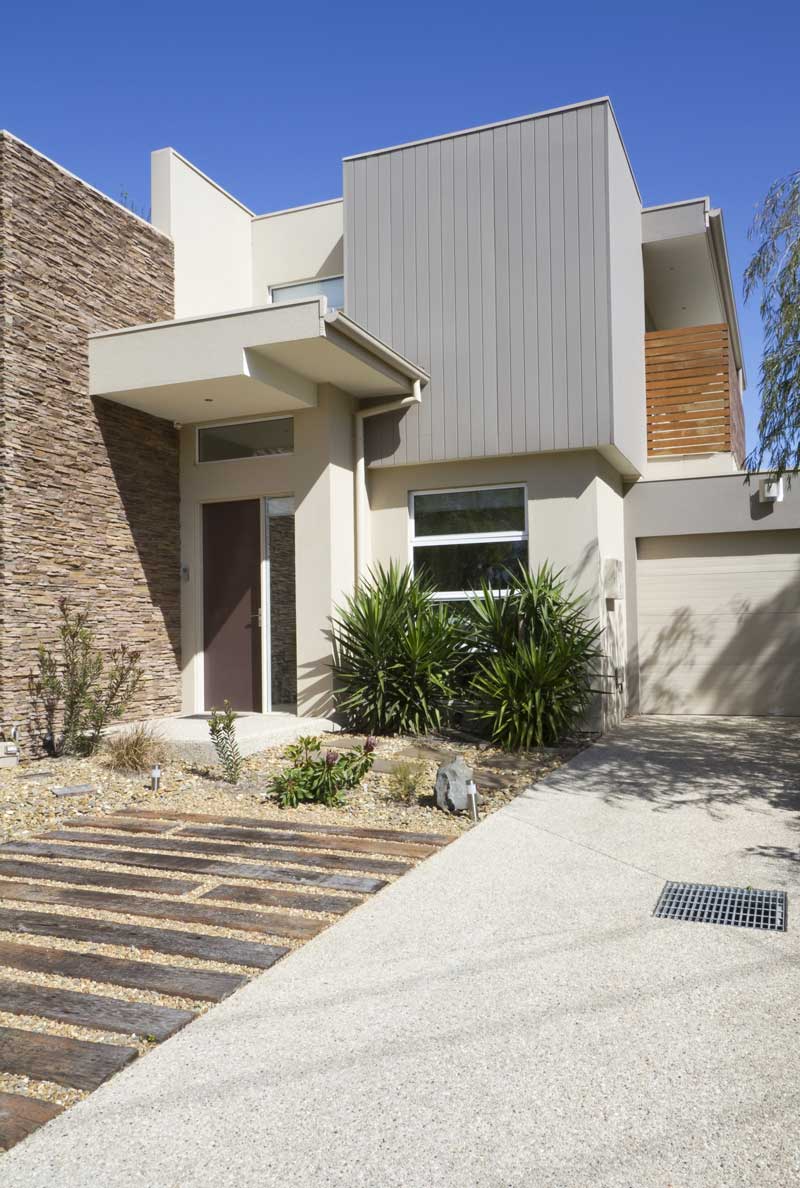
This garden is full of reflective heat sources. Some plants will be shaded for much of the day, while others will experience the full force of the midday and afternoon for more than 6 hours. https://www.shutterstock.com/image-photo/side-angle-double-storey-architec-designed-85178254
Reflective Heat Sources vs. Absorptive Materials
Reflective heat sources, such as rocks, pebbles, concrete, sand, and glass, increase the intensity of heat around them by reflecting sunlight. This reflection can lead to higher temperatures at the surface and in the soil, creating harsh conditions for plant growth.
In contrast, materials that absorb and reduce heat, like plants, wood, mulch, organic matter, and moisture, help to moderate temperature fluctuations. These absorptive materials retain heat during the day and release it slowly at night, providing a more stable environment for plants.
Growing Conditions for Ground Cover Plants in Reflective Heat Environments
When selecting ground cover plants for areas near reflective heat sources, consider the following growing conditions:
Soil Moisture
Reflective surfaces can cause rapid evaporation of soil moisture. To counteract this, ensure regular watering and consider using mulch or vegetation to retain soil moisture. Choosing good quality ground-covering plants that can tolerate the heat as they establish will do wonders to mitigate the radiating heat.
Soil Quality
Ensure the soil is well-draining but capable of retaining sufficient moisture. Adding organic matter can improve both water retention and soil structure. On the other hand, choosing tough plants that can handle harsh conditions means you won’t have to babysit them.
Shade Consideration
If possible, provide partial shade during the hottest part of the day to mitigate the intensity of reflected heat. Again, choosing tough plants can remove the need for babysitting them.
Wind Protection
Reflective surfaces can increase the drying effects of wind. Implementing windbreaks or strategic planting can help reduce this impact.
Tolerance Requirements for Plants in Harsh Heat
To thrive in these harsh conditions, plants need to exhibit specific tolerances:
Heat Tolerance
Plants must withstand high temperatures without wilting or scorching.
Drought Resistance
Drought-resistant plants can survive with minimal water.
Reflective Heat Tolerance
Plants should tolerate the additional heat reflected from nearby surfaces. While this tolerance may not be included in a plant label, the tolerance to heat and drought should be included and will help you discover whether your chosen plant is suitable.
Resilience to Soil Conditions
Plants should thrive in less-than-ideal soil conditions often found near reflective surfaces. This includes tolerating poor, sandy, hydrophobic, compacted, or rocky soils.
Choosing High-Quality Plants
When selecting plants for these challenging conditions, you can end up saving money in the long run by investing in better bred plants which are less likely to need replacing because they won’t die as easily. Consider the following:
Healthy Roots
Choose plants with robust, healthy root systems and avoid those with signs of disease or root rot. Check roots while at the nursery.
Acclimatised Varieties
Opt for native or well-acclimatised varieties known to thrive in your specific environment. “Native” plants may or may not be suitable, because they’ve adapted to vastly different climates around this giant continent. Also, focus on the variety more than the species, because varieties within the same species will all perform differently depending on their genetics.
Disease Resistance
Select varieties that are resistant to common pests and diseases in your area. Again, focus on the variety level because some cultivars are more resistant to certain pests and diseases than their closely-related brothers and sisters within the same species.
Local Expertise
Consult local nurseries or gardening experts who can provide insights into the best-performing plants in your region’s climate and conditions.
Best Native Ground Cover Plants Near Reflective Heat
In the following section, we’ll go over some excellent plants that can tolerate the harsh heat and drought commonly experienced in garden positions that experience reflective heat.
Remember that heat is not the only tolerance they’ll need, and you should also take into account factors such as the position’s drainage capacity, amount of sunlight, the level of maintenance you’re willing to put in, and so forth. With that being said, all of the plants below are incredibly tough and you’re sure to find several options that can tolerate the unique requirements of your landscape design.
Tasred® Dianella tasmanica ‘TR20’ PBR
Tasred® Dianella is a hardy, adaptable plant with a dense, tidy appearance, wide leaves, and large purple berries in spring and summer. It often exhibits red tinges at the base in colder climates, and can tolerate full sun with reflective heat to heavy shade. Keep it away from constant moisture and humidity.
Size: This plant grows to 45 cm in height and spreads 40-50 cm wide. For optimal growth, plant density should be 4-6 plants per square metre or 2-4 plants per linear metre.
Climate Tolerance: Tasred® Dianella thrives in a range of conditions from full sun to heavy shade and tolerates frost and heat. It is suitable for sandy, sandy loam, and clay soils but should be avoided in very poor soils. It performs well in NSW, ACT, VIC, TAS, SA, WA, and non-humid areas of QLD.

https://www.ozbreed.com.au/plant-ranges/strappy-leaf-plants/tasred-dianella/
Little Rev™ Dianella revoluta ‘DR5000’ PBR
Little Rev™ Dianella is a hardy plant with compact blue-grey foliage and a great architectural form, perfect for modern landscapes. It blooms with small purple flowers from October to November. Again, keep this dianella away from constant moisture and humidity.
Size: This plant reaches 30-40 cm in height and width. For optimal growth, plant density should be 6-10 plants per square metre or 3-5 plants per linear metre.
Climate Tolerance: Little Rev™ Dianella thrives in full sun to moderate shade and tolerates drought and frost. It suits moderately heavy to free-draining soils but should be avoided in very poor soils. It performs well in ACT, VIC, SA, WA, TAS, and NSW (provided the soil is well-draining).
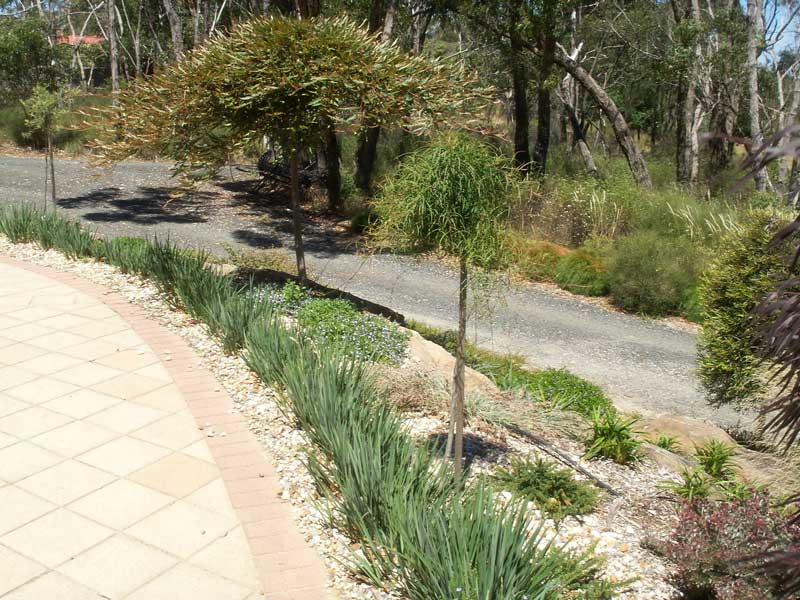
https://www.ozbreed.com.au/plant-ranges/strappy-leaf-plants/little-rev-dianella/
Cassa Blue® Dianella caerulea ‘DBB03’ PBR
Cassa Blue® Dianella is a compact, clumping plant with striking blue foliage and masses of purple and yellow flowers from September to November. It is ideal for commercial or residential gardens.
Size: This plant grows to 50 cm in height and 40 cm in width. For optimal growth, plant density should be 4-8 plants per square metre or 2-4 plants per linear metre.
Climate Tolerance: Cassa Blue® Dianella thrives in full sun to partial shade and tolerates drought and cold. It prefers well-drained soils and is suitable for ACT, VIC, SA, WA, TAS, and NSW (north of Sydney only for maintained gardens) & QLD (only for maintained gardens where you prune them to the base as vegetation becomes thick enough to block airflow).
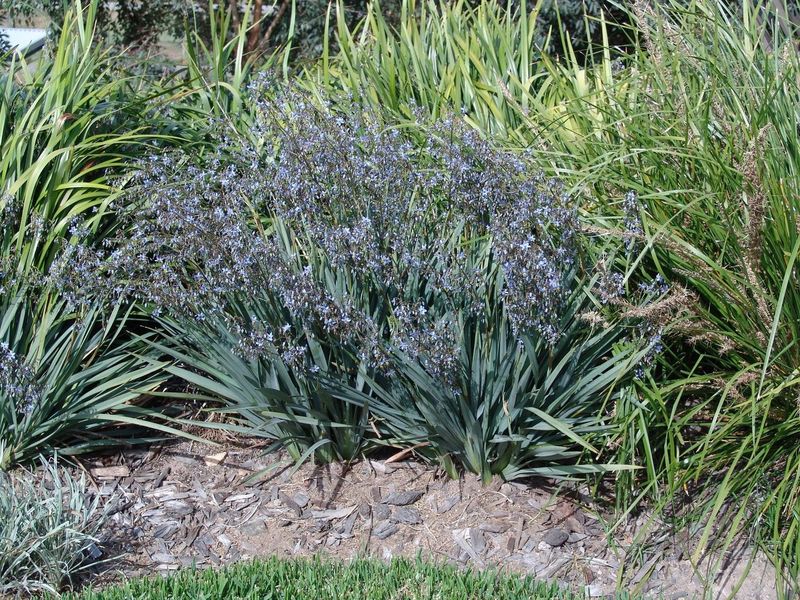
https://www.ozbreed.com.au/plant-ranges/strappy-leaf-plants/cassa-blue-dianella/
Clarity Blue™ Dianella hybrid ‘DP401’ PBR
Clarity Blue® Dianella is a hardy plant with clean blue foliage and small purple flowers from September to November. It is ideal for mass planting or as an accent plant. Unlike other dianellas, this variety can handle short periods with wet feet, so is better for positions that may receive a lot of rainfall now and then, but will not retain that moisture too long in the soil.
Size: This plant reaches 50-60 cm in height and width. For optimal growth, plant density should be 4-6 plants per square metre or 2-3 plants per linear metre.
Climate Tolerance: Clarity Blue® Dianella thrives in full sun to part shade and tolerates drought and frost. It performs well in ACT, VIC, SA, WA, TAS, and NSW (provided the soil is well-draining).
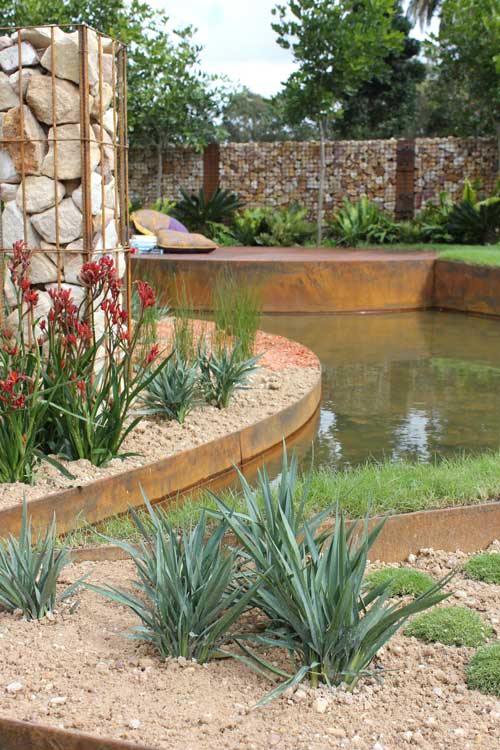
https://www.ozbreed.com.au/plant-ranges/strappy-leaf-plants/clarity-blue-dianella/
Tanika® Lomandra longifolia ‘LM300’ PBR
Tanika® Lomandra is a low-maintenance, evergreen plant with compact fine leaves and small yellow flowers from April to October. It has been a reliable choice for Australian landscapes for over a decade and is soft to touch. In the next few years, this variety will be replaced with a new variety which we will call Tanika® Lomandra that will have a better tolerance for wet feet. In the meantime, the Classic Tanika® Lomandra is almost bulletproof as long as it doesn’t experience wet feet or humidity.
Size: This plant grows to 50-60 cm in height and 65 cm in width. For optimal growth, plant density should be 3-6 plants per square metre or 2-3 plants per linear metre.
Climate Tolerance: Tanika® Lomandra thrives in full sun to moderate shade and tolerates drought and frost. It suits sandy loam to clay soils but should avoid wet feet. Suitable for NSW, ACT, VIC, SA, WA, TAS, and non-humid regions of QLD.
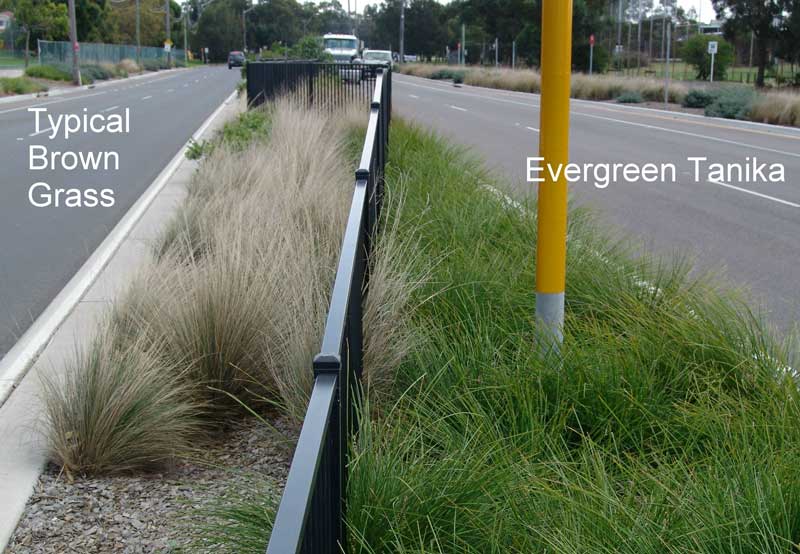
https://www.ozbreed.com.au/plant-ranges/strappy-leaf-plants/tanika-lomandra/
Shara™ Lomandra fluviatilis ‘ABU7’ PBR
Shara™ Lomandra is a compact plant with fine blue-grey foliage and masses of yellow flowers. It is drought-tolerant, phytophthora tolerant, and suitable for erosion control. It’s also tolerant of hot temperatures and poor soils.
Size: This plant grows to 45-55 cm in height and 50 cm in width. For optimal growth, plant density should be 4-6 plants per square metre or 2-3 plants per linear metre.
Climate Tolerance: Shara™ Lomandra thrives in full sun to moderate shade, tolerates drought and very cold temperatures, and suits a wide variety of soils, including those that experience periodic flooding. Suitable for QLD, NSW, ACT, VIC, TAS, SA, and WA.

https://www.ozbreed.com.au/plant-ranges/strappy-leaf-plants/shara-lomandra/
Wingarra® Lomandra confertifolia ‘SIR5’ PBR
Wingarra® Lomandra is a dense, compact plant with blue-grey foliage and small cream flowers in spring. It looks like a grass but rarely needs trimming. Many horticulturists and landscape designers particularly love it for its strong architectural form and low maintenance.
Size: This plant grows to 40 cm in height and width. For optimal growth, plant density should be 6-10 plants per square metre or 3-5 plants per linear metre.
Climate Tolerance: Wingarra® Lomandra thrives in full sun to part shade, tolerates drought and moderate frost, and suits well-drained soils. Suitable for NSW, ACT, VIC, TAS, SA, WA, and non-humid areas of QLD.

https://www.ozbreed.com.au/plant-ranges/strappy-leaf-plants/wingarra-lomandra/
Great White™ Lomandra longifolia ‘MURU’ PBR
Great White™ Lomandra features variegated foliage and larger flowers, similar in shape to Katrinus Deluxe™ Lomandra. It a beautiful dense, compact form and non-seeding nature. While this plant is a beautiful feature plant, it’s best to give it a water during dry periods, especially when it’s in reflective heat. If it’s near reflective heat sources, this variety will do best in areas south of Sydney.
Size: This plant grows to 40-50 cm in height and width. For optimal growth, plant density should be 4-6 plants per square metre or 2-3 plants per linear metre.
Climate Tolerance: Great White™ Lomandra thrives in full sun to moderate shade and tolerates drought, cold, and windy, salt-laden conditions. It suits sandy, sandy loam to clay soils. Suitable for Southern NSW, VIC, SA, WA, TAS, and parts of Sydney with free-draining soil. Not recommended for Queensland except for areas like Toowoomba.

https://www.ozbreed.com.au/plant-ranges/strappy-leaf-plants/great-white-lomandra/
Ozbreed Flat White™ Pandorea jasminoides ‘PJ01’ PBR
Ozbreed Flat White™ Pandorea is a dense, compact climber or creeper with masses of pure white flowers in late spring and summer. Ideal for narrow spaces because it grows flat against a trelis or along the ground better than other varieties (which tend to take over a space without lots of pruning). This is probably the best native plant for growing both up and down retaining walls while remaining aesthetically pleasing.
Size: This plant grows 2-3 metres high and 40-60 cm wide when pruned (80 cm to 2 metres unpruned). For optimal growth, plant density should be 1-3 plants per linear metre.
Climate Tolerance: Ozbreed Flat White™ Pandorea thrives in full sun to part shade, suits most soil types, and has moderate frost and good drought tolerance. Suitable for South QLD, NSW, VIC, TAS, SA, and WA.

https://www.ozbreed.com.au/plant-ranges/native-shrubs-groundcovers/ozbreed-flat-white/
Aussie Rambler™ Carpobrotus glaucescens ‘CAR10’ PBR
Aussie Rambler™ Carpobrotus, a native pigface, is a prostrate creeping succulent with long trailing stems up to 2 metres. It produces large deep pink flowers in spring and autumn and has purple stems. It naturally grows on sand dunes which reflect a lot of heat without retaining water, with the added bonus of tolerating coastal salt spray.
Size: This plant grows to 20 cm in height and spreads up to 2 metres. For optimal growth, plant density should be 1-2 plants per square metre.
Climate Tolerance: Aussie Rambler™ Carpobrotus thrives in full sun to light shade, suits most soil types, and tolerates frost, drought, humidity, and salt. It should avoid prolonged wet feet. Suitable for QLD (excluding northern QLD), NSW, ACT, VIC, TAS, SA, and WA.
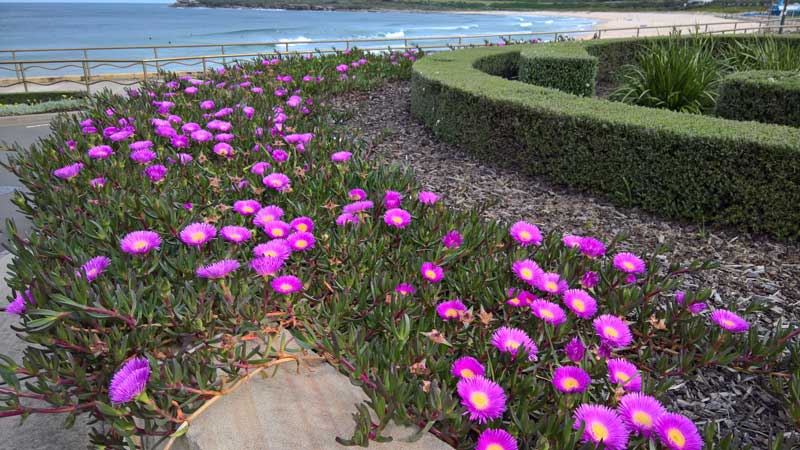
Blue Horizon™ Eremophila glabra prostrate ‘EREM1’ PBR
Blue Horizon™ Eremophila is a low-growing ground cover emu bush with tidy blue-grey foliage and yellow flowers in winter. Its shorter internodes provide a denser and tidier appearance. Belonging to a genus that’s well known for existing in the poor sandy soils of Western Australia, this variety has been bred to tolerate climates that other eremophilas cannot.
Size: This plant grows to 25 cm in height and 1 metre in width. For optimal growth, plant density should be 1-2 plants per square metre or per linear metre.
Climate Tolerance: Blue Horizon™ Eremophila thrives in full sun to light shade, prefers free-draining soil but can handle heavier soils in drier climates, and is drought-tolerant. Suitable for SA, WA, VIC, Sydney, and Southern NSW (requires free-draining soil in Sydney).
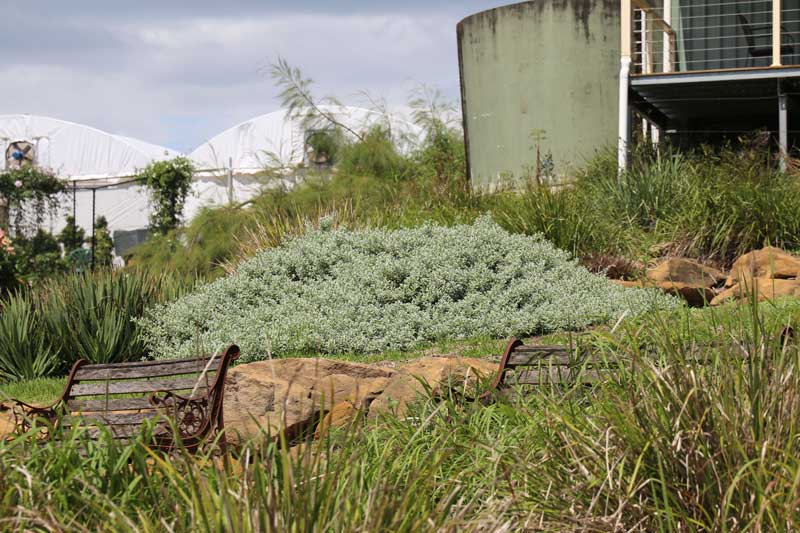
https://www.ozbreed.com.au/plant-ranges/native-shrubs-groundcovers/blue-horizon-eremophila/
Aussie Flat Bush™ Rhagodia spinescens ‘SAB01’ PBR
Aussie Flat Bush™ Rhagodia is a low-growing, compact shrub with blue foliage. It performs well in both inland and coastal areas and is ideal for roadsides and landscapes. Pruning is recommended for a manicured look, especially if you wish to keep it low.
Size: This plant grows to 30-50 cm in height and 1 metre in width. For optimal growth, plant density should be 1-2 plants per square metre or per linear metre.
Climate Tolerance: Aussie Flat Bush™ Rhagodia thrives in full sun to light shade, suits most soil types including heavy soils, and is highly drought-tolerant. In fact, it’s potentially one of the most resilient plants for both coastal and dry inland positions. It can withstand frost down to -5°C. Suitable for NSW, ACT, VIC, QLD (non-humid inland areas), SA, and WA.
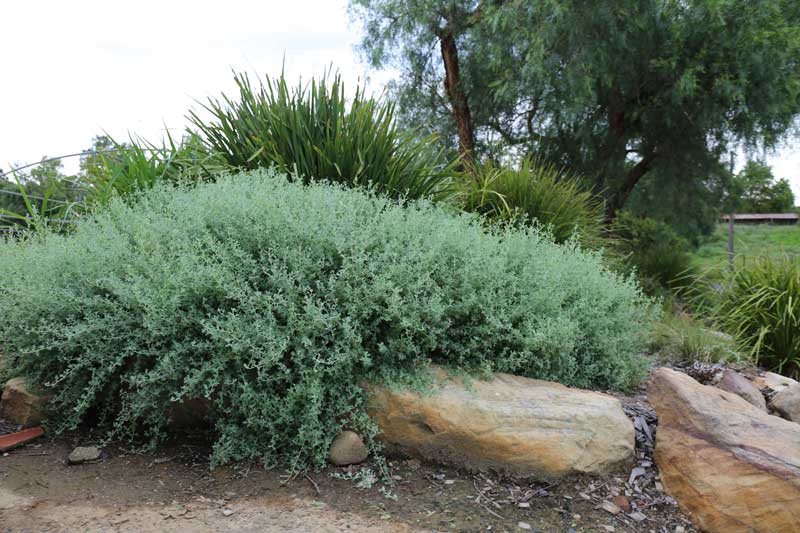
Cherry Cluster™ Grevillea rhyolitica x juniperina ‘TWD01’ PBR
Cherry Cluster™ Grevillea is a semi-prostrate ground cover with clean, tidy foliage and masses of showy cherry flowers in autumn, winter, and spring. This plant provides resources for pollinators when few other plants are flowering in winter, and also provides an early resource for pollinators as they build numbers in late winter and early spring, setting your garden up with pest-eating allies for the whole year.
Size: This plant grows to 50 cm in height and 80 cm in width. For optimal growth, plant density should be 2-3 plants per square metre.
Climate Tolerance: Cherry Cluster™ Grevillea thrives in full sun to part shade, prefers well-drained soils, and prefers soils with a pH below 7. It is drought and frost tolerant down to -5°C. Suitable for ACT, VIC, TAS, SA, WA, NSW (especially Sydney and south), and parts of South East QLD (non-humid regions like Toowoomba).
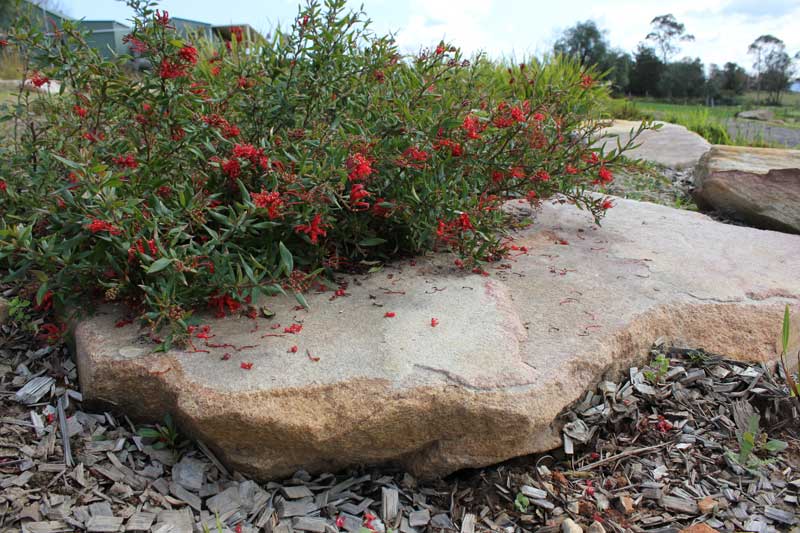
https://www.ozbreed.com.au/plant-ranges/native-shrubs-groundcovers/cherry-cluster-grevillea/
Low Horizon™ Westringia fruticosa ‘WES06’ PBR
Low Horizon™ Westringia is a dense, ultra-compact ground cover with much shorter internodes and a flat habit, making it potentially the lowest maintenance Westringia variety available. Occasional pruning enhances its tight appearance, but is not required.
Size: This plant grows to 30 cm in height and 70 cm in width. For optimal growth, plant density should be 2-3 plants per square metre or per linear metre.
Climate Tolerance: Low Horizon™ Westringia thrives in full sun to part shade, suits sandy to well-drained clay soils, and tolerates cold and drought. It handles frost and humidity well, even in freezing Canberra where other varieties struggle. Currently being tested for wet feet tolerance in Queensland. Suitable for NSW, VIC, SA, WA, ACT, and TAS.
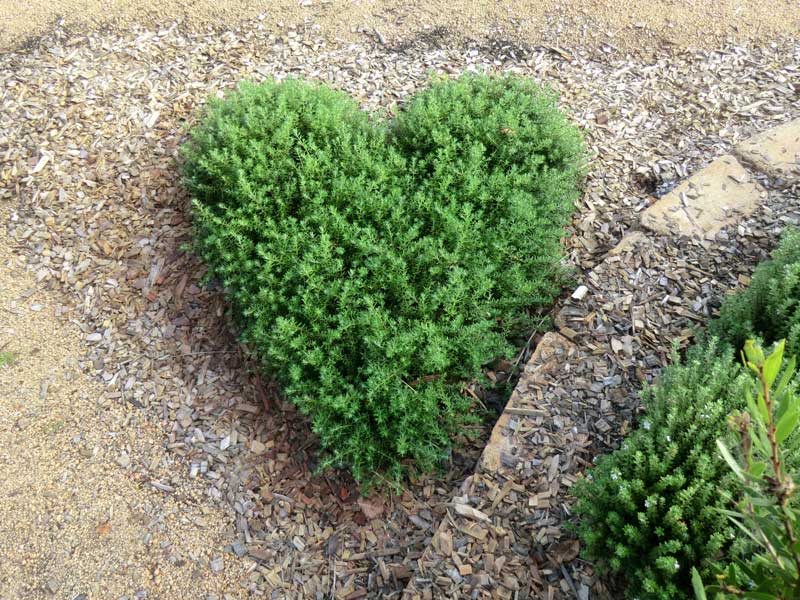
Mundi™ Westringia fruticosa ‘WES05’ PBR
Mundi™ Westringia is a versatile ground cover with masses of white flowers. It maintains a tidy form whether pruned or left unpruned and is ideal for low-maintenance gardens and tough roadside plantings without irrigation or drainage, because it can tolerate both drought and extreme flooding.
Size: This plant grows to 40-50 cm in height and 1.5 metres in width. For optimal growth, plant density should be 1-3 plants per square metre.
Climate Tolerance: Mundi™ Westringia thrives in full sun to part shade, suits sandy to well-drained clay soils, and tolerates cold and drought. It can survive on natural rainfall along most of the east coast of Australia. Suitable for QLD, NSW, VIC, TAS, SA, WA, and ACT (prefers shelter from heavy frost in ACT).
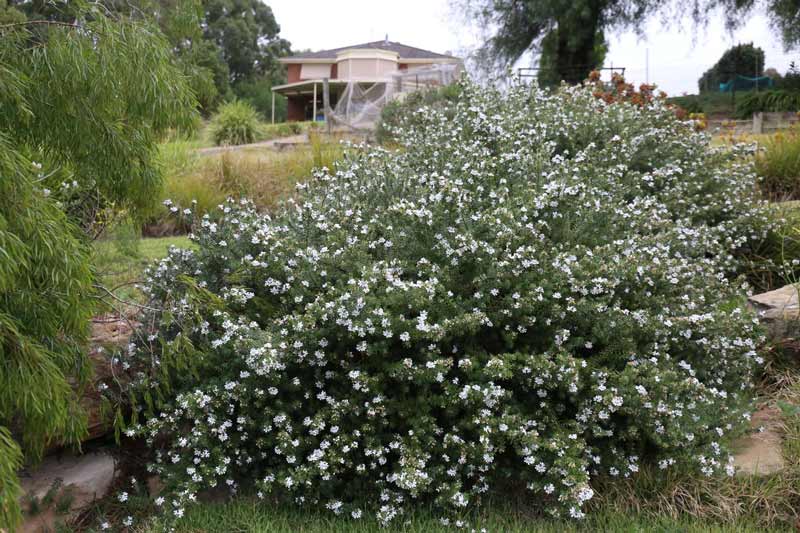
https://www.ozbreed.com.au/plant-ranges/native-shrubs-groundcovers/mundi-westringia-is-a-tough-and-beautiful-ground-cover-shrub-with-masses-of-flowers-native-shrubs-ground-covers/
Pink Fusion™ Scaevola spp. ‘PFS200’ PBR Intended
Pink Fusion™ Scaevola is a tough, low-maintenance ground cover with compact green foliage and beautiful pink fan flowers. It flowers almost all year round and effectively outcompetes weeds better than other varieties.
Size: This plant grows to 30 cm in height and spreads up to 1.2 metres wide in good soils (80 cm in poorer soils). For optimal growth, plant density should be 1-2 plants per square metre.
Climate Tolerance: Pink Fusion™ Scaevola thrives in full sun to light shade, tolerates heat, cold, drought, and semi wet feet. Suitable for planting Australia-wide.
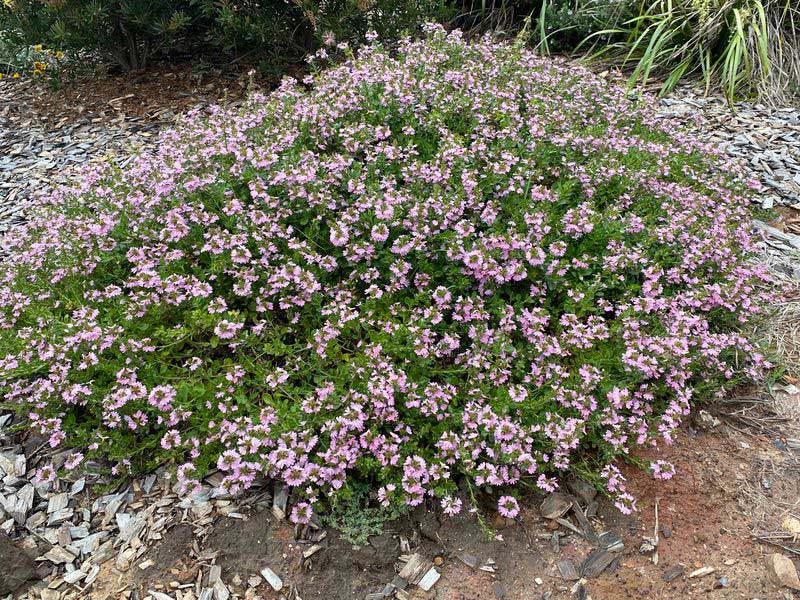
https://www.ozbreed.com.au/plant-ranges/native-shrubs-groundcovers/pink-fusion/
Yareena™ Myoporum parvifolium ‘PARV01’ PBR
Yareena™ Myoporum is a longer-lived ground cover with crisp, clean foliage and masses of white flowers. Its thick, woody stems enhance its longevity, and don’t defoliate as easily as other varieties.
Size: This plant grows to 10 cm in height and 1 metre in width. For optimal growth, plant density should be 1-2 plants per square metre.
Climate Tolerance: Yareena™ Myoporum thrives in full sun to part shade and suits sandy to heavy clay soils. It is highly drought and frost tolerant. Suitable for QLD, NSW, ACT, VIC, TAS, SA, and WA.

Best Exotic Ground Cover Plants Near Reflective Heat
Isabella® Liriope muscari ‘LIRF’ PBR
Isabella® Liriope is a fine-leaf, compact spreading plant with beautiful pink flowers. It serves as an excellent lawn alternative or garden border, outperforming mondo grass in full sun, drought, and frost conditions.
Size: This plant grows to 40 cm in height and 50 cm in width. When mown or brush cut once a year, its regrowth height reduces to 15-20 cm and width to 20-30 cm. For optimal growth, plant density should be 6-12 plants per square metre or 4-8 per linear metre.
Climate Tolerance: Isabella® Liriope thrives in full sun to 90% shade and tolerates frost, drought, flooding and humidity. It suits all soil types and is suitable for NSW, ACT, QLD, VIC, SA, WA, TAS, and NT.

https://www.ozbreed.com.au/plant-ranges/strappy-leaf-plants/isabella-liriope/
Double Gold™ Gazania hybrid ‘GT20’ PBR
Double Gold™ Gazania is a fast-establishing, sterile spreading ground cover with clean foliage and an abundance of yellow flowers appearing most of the year. It requires minimal care once established and effectively outcompetes weeds.
Size: This plant grows to approximately 20 cm in height and 60 cm in width. For optimal growth, plant density should be 3-5 plants per square metre or 2-4 per linear metre.
Climate Tolerance: Double Gold™ Gazania thrives in full sun, tolerates frost and drought, and suits free-draining to heavy clay soils. Suitable for NSW, VIC, TAS, SA, WA, and QLD (excluding northern QLD).
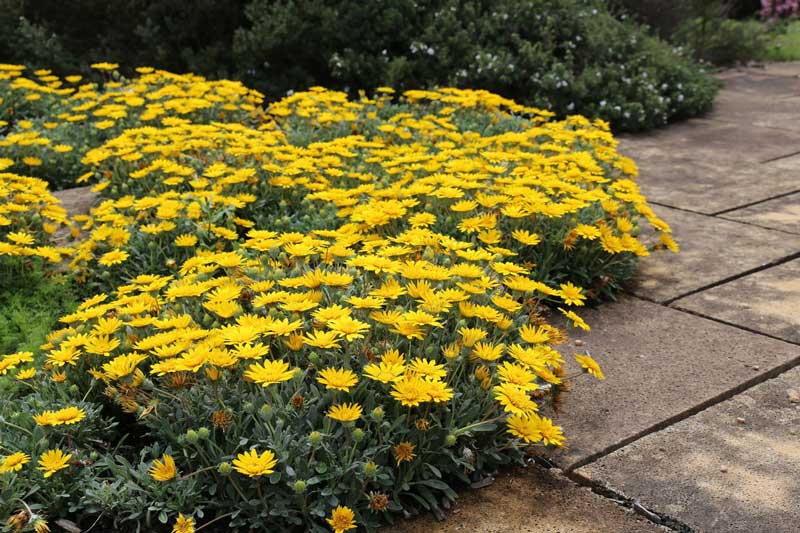
Flat Mat™ Trachelospermum asiaticum ‘FT01’ PBR
Flat Mat™ Trachelospermum is a low-growing ground cover that establishes more quickly than the common form. It can also be used as a flatter climber when supported on trellises and similar structures, requiring minimal pruning compared with faster-growing and larger varieties.
Size: This plant grows to 30-40 cm in height and spreads 3-4 m in width. For optimal growth, plant density should be 1-2 plants per square metre or linear metre.
Climate Tolerance: Flat Mat™ Trachelospermum thrives in full sun to part shade, tolerates drought and cold, and suits most soil types. Suitable for QLD, NSW, ACT, VIC, TAS, NT, SA, and WA.
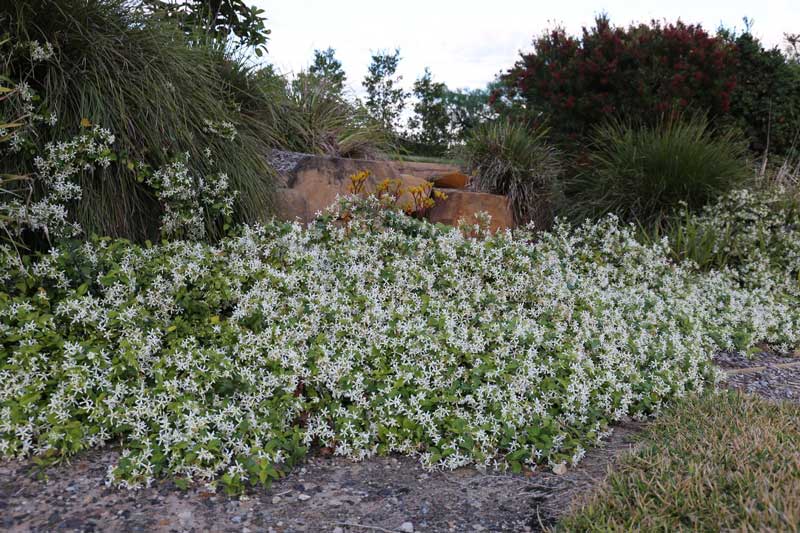
https://www.ozbreed.com.au/plant-ranges/hardy-exotic-range/flat-mat-trachelospermum/
Ozbreed Zen Grass® Zoysia spp. ‘ZOY01’ PBR
Ozbreed Zen Grass® Zoysia is a low-maintenance, fast-spreading lawn alternative with a unique rippling surface. It requires mowing only once per year and effectively reduces weed invasion. Its rippling growth habit is quite striking and adds an interesting texture to the landscape
Size: This plant grows to 10-20 cm in height and spreads to 1 metre in width. For optimal growth, plant density should be 7-9 plants per square metre or 27-9 per linear metre.
Climate Tolerance: Zen Grass® Zoysia thrives in full sun to shade, tolerates drought, frost, heat, and even floods. It suits most soil types with low fertiliser requirements. Suitable for use across Australia with trial results from QLD and ACT.
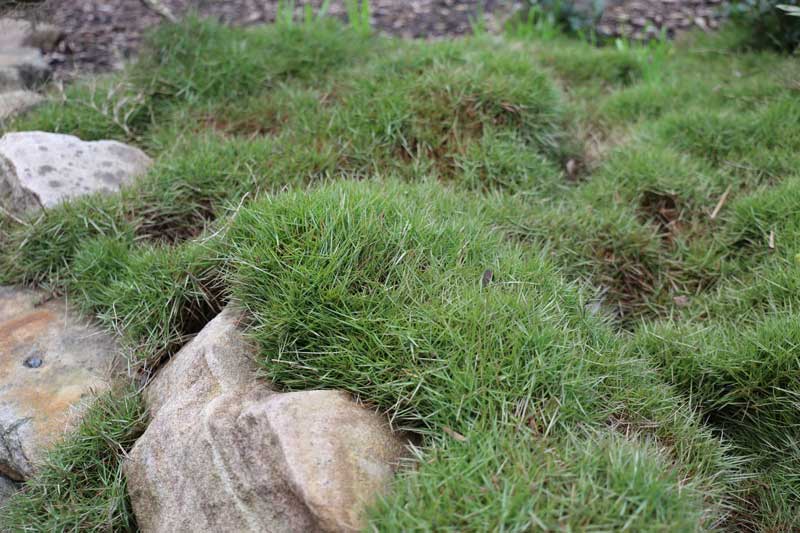
https://www.ozbreed.com.au/plant-ranges/hardy-exotic-range/zen-grass-zoysia/
Conclusion
Understanding the conditions imposed by reflective heat sources and selecting appropriate ground cover plants can transform a challenging garden space into a thriving, resilient area. By considering factors like soil moisture, quality, and plant tolerances, you can successfully cultivate a beautiful garden even in harsh heat environments.
